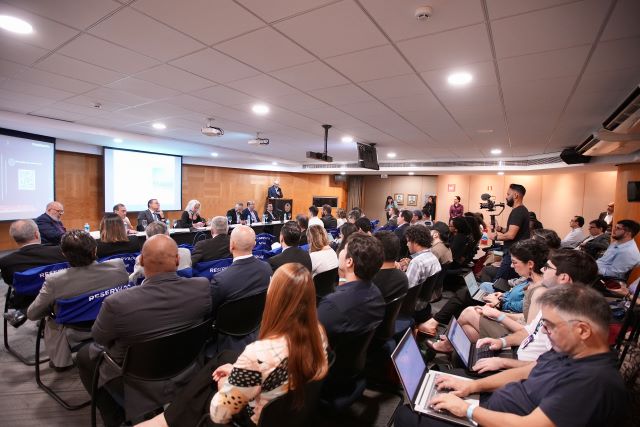


A ceremony was held to open the center on October 23 at FGV (photo: Piti Reali/EAESP-FGV).
Published on 11/06/2023
By André Julião | Agência FAPESP – Recent school shootings by teenagers in Brazil have once again highlighted the urgent need to prevent crimes of this kind. Because they are normally planned and even forewarned on social media, data analysis and the use of artificial intelligence (AI) tools have the potential to predict and prevent them.
This will be one of the research interests of the Public Safety Analytics and Policy Research Center (FGV Analytics), a Science for Development Center (SDC) funded by FAPESP and set up at Getúlio Vargas Foundation (FGV) in partnership with the São Paulo State Department of Public Safety (SSP-SP) and the University of São Paulo (USP).
“The methodology used is problem-solution coupling. Issues will be analyzed by a group comprising not just researchers but also public safety professionals who have experienced them. The aim is to arrive at technological results that help organize the phenomenon and the solution,” João Luiz Becker, a professor at FGV’s São Paulo Business School (EAESP) and principal investigator for FGV Analytics, told Agência FAPESP.
“The establishment of a research center on public safety policy is excellent news for the academic community, for the government agencies involved with public safety, and ultimately for the general public in São Paulo State. The initiative has a very special component, as it stimulates the academic and scientific community to engage in a strenuous effort to address the problems of public safety and seek solutions based on science and technology,” said Marco Antonio Zago, President of FAPESP, during the ceremony held on October 23 to unveil the center at FGV.
For Zago, FGV Analytics shows that public safety is not the responsibility of the state alone but of everyone in society, including researchers. As a public policy development project, its activities will not be confined to knowledge advancement but will include solving the problems addressed.
Launched by FAPESP in 2020, the SDC program supports five-year research projects with social, technological and economic impacts conducted by teams at research institutions and universities or other higher education institutions in São Paulo State in partnership with government bodies (more at: https://agencia.fapesp.br/38813).
João Henrique Martins, General Coordinator of the São Paulo State Department of Public Safety's Integrated Command and Control Center (CICC) and Deputy Director of FGV Analytics, spoke about the recent surge in so-called “PIX kidnappings”, where victims are abducted and forced to transfer cash from their bank account in order to be released. PIX is an instant payment platform created and managed by the Central Bank of Brazil.
To investigate these crimes, he stressed, police intelligence units and banks need to work together without disregarding the chain of custody (CoC), in which the state is responsible for assuring the physical security of digital forensic evidence.
“We soon realized we needed a center like this and researchers with solutions to protect the CoC while providing a fast flow of information. We’ll focus on a small number of problems, and whatever exists scientifically speaking can be used in our solutions. The center will be a first of its kind in terms of combining a scientific methodology with operational practice. That’s the challenge we face,” Martins said.
School shootings
On the subject of school shootings, Martins told Agência FAPESP that at least two points need to be taken into account: identification of possible attackers as early as possible to facilitate both prevention and future investigations; and identification of fake news spreaders who fuel panic after a school shooting.
“It’s a major challenge because digital media have so many channels, and we have to analyze the flow of communication on social media in search of signs that an active shooter is about to pop up. They may be spreading certain kinds of misinformation or they might be a victim of bullying. We also need to look for signs of radicalization,” he said. “The university can treat this as a research hypothesis, analyzing it in depth and bringing whatever is at the knowledge frontier to bear on what can be operationalized.”
The event was mediated by Goret Pereira Paulo, head of FGV’s research network, and featured state prosecutor Fabio Bechara, as well as researchers Eduardo Francisco, Leandro Piquet, Roberto Speicys e Ciro Biderman, who will be part of the center’s team of analysts.
Also attending were Paulo Maculevicius, Chief of Staff at the Department of Public Safety, representing Guilherme Derrite, Secretary of the Department; Luiz Artur Ledur Brito, Director of EAESP-FGV; and Pedro Abreu Dallari, Director of USP’s Institute of International Relations.
Source: https://agencia.fapesp.br/50158